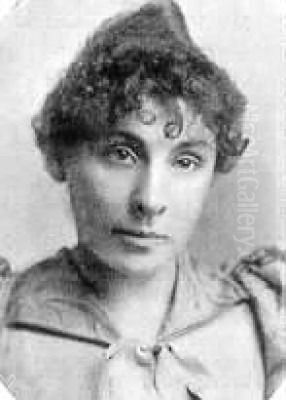
Henrietta Emma Ratcliffe Rae, a prominent figure in the late Victorian art world, carved a significant niche for herself through her dedication to classical, allegorical, and literary themes. Born on December 30, 1859, in Hammersmith, London, Rae emerged during an era when female artists faced considerable societal and institutional barriers. Yet, through talent, perseverance, and a keen understanding of academic traditions, she became one of the most respected and exhibited female painters of her time, leaving behind a legacy of ambitious and often sensuous works.
Early Life and Artistic Awakening
Henrietta Rae's upbringing provided a fertile ground for her artistic inclinations. Her mother, Ann (née Graves), was a musically gifted woman, having studied under Felix Mendelssohn, the renowned German composer. This artistic environment likely fostered a sensitivity to the arts in young Henrietta. Her father, Thomas Rae, was a civil servant. She also had an uncle, Charles Rae, who was an artist himself, providing a more direct familial link to the visual arts. Growing up as the youngest of seven children, Henrietta displayed an early passion for drawing and painting.
Her formal artistic education began at the tender age of thirteen. She initially enrolled at the Queen Square School of Art, a notable institution for aspiring artists. Rae's ambition and talent were evident as she progressed to Heatherley's School of Fine Art. Significantly, she was the first female student to be admitted to Heatherley's, a testament to her determination in an era when opportunities for women in the arts were limited. Her studies also included time spent at the British Museum, where she could immerse herself in classical sculpture and antiquities, which would profoundly influence her later subject matter.
The Royal Academy Schools and Formative Influences
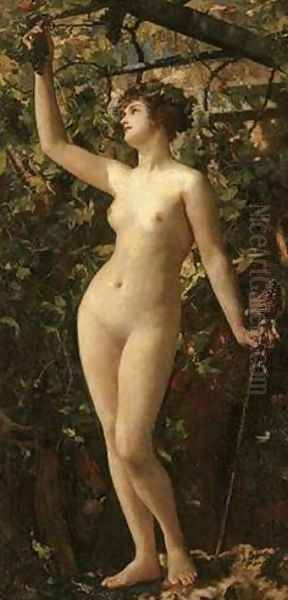
The Royal Academy of Arts was the pinnacle of artistic aspiration in Britain, and Rae set her sights on gaining admission to its prestigious schools. Her path was not immediate; she applied multiple times before finally being accepted. This persistence paid off handsomely when she was awarded a seven-year scholarship to the Royal Academy Schools. This was a significant achievement, providing her with rigorous training in drawing, painting, and composition, adhering to the academic traditions that emphasized historical and mythological subjects.
During her time at the Royal Academy Schools, and in her subsequent career, Rae came under the influence of several leading artists of the day. One of the most notable was Sir Lawrence Alma-Tadema. A Dutch-born painter who settled in England, Alma-Tadema was celebrated for his meticulously detailed and archaeologically informed depictions of life in ancient Greece, Rome, and Egypt. His influence can be seen in Rae's careful attention to classical settings, drapery, and the overall polished finish of her canvases. Other prominent academicians of the era, such as Frederic Leighton, President of the Royal Academy, and Sir Edward Poynter, also championed classical subjects, creating a prevailing artistic climate that Rae navigated and contributed to.
Marriage and Artistic Partnership
In 1884, Henrietta Rae married fellow artist Ernest Normand (1857–1923). Normand was also a painter, known for his historical and biblical scenes, often with an Orientalist flavour. Their marriage was a partnership both personal and professional. They established a studio in Holland Park, a fashionable artistic enclave in London, where neighbours included prominent figures like Leighton and G.F. Watts.
The couple often worked in close proximity, and their artistic careers, while distinct, sometimes intersected. In 1890, Rae and Normand travelled to Paris to further their studies. They enrolled at the Académie Julian, a progressive private art school that, unlike many official academies at the time, welcomed female students and offered them the opportunity to draw from the male nude model – a crucial aspect of academic training often denied to women. In Paris, they studied under artists like Jules Joseph Lefebvre and Jean-Joseph Benjamin-Constant, absorbing the techniques and aesthetics of French academic painting. This period abroad undoubtedly broadened Rae's artistic horizons and refined her technical skills. Later, in 1893, the couple moved to Upper Norwood, in South London, where they built a glasshouse studio, allowing them to work on large-scale canvases.
Artistic Style and Thematic Concerns
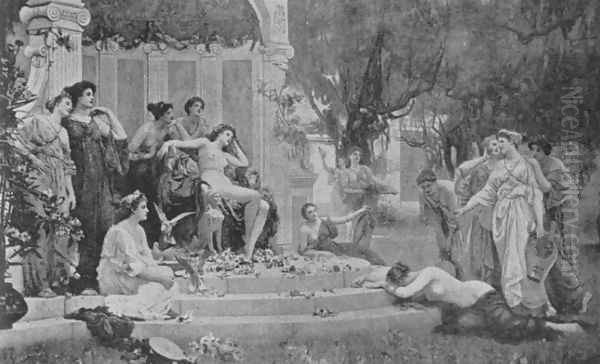
Henrietta Rae's artistic style is firmly rooted in the late Victorian academic tradition, often described as Neoclassical or Classical Revival. Her work is characterized by a strong emphasis on draughtsmanship, balanced compositions, a rich colour palette, and a smooth, polished finish. She excelled in depicting the human form, particularly the female nude, which became a recurring and sometimes controversial element in her oeuvre.
Her thematic concerns were predominantly drawn from classical mythology, allegorical subjects, and literary sources. These themes provided ample opportunity to explore universal human emotions, moral narratives, and idealized beauty. Works like A Bacchante (1885) and Ariadne (1885) demonstrate her early engagement with mythological figures, often imbued with a sensuous quality. She was adept at capturing dramatic moments and conveying narrative through gesture and expression, a skill honed through her academic training. While her style aligned with established academic painters, it also possessed a distinct sensitivity, particularly in her portrayal of female figures, which often went beyond mere decorative objects to explore their psychological states.
Navigating the Nude
Rae's commitment to painting the nude, especially the female nude, was a bold stance for a woman artist in Victorian England. While male artists like Leighton, Alma-Tadema, and Poynter frequently depicted nudes within classical or mythological contexts, it was considered by some to be an inappropriate subject for female artists to tackle, let alone excel in. The societal constraints and expectations placed upon women often limited their access to life models and discouraged them from exploring themes deemed too risqué.
Henrietta Rae, however, challenged these conventions. She believed in the artistic importance of the nude as the highest form of art, essential for depicting mythological and allegorical subjects accurately and powerfully. Her nudes are typically idealized, conforming to classical aesthetics, but they also possess a vitality and presence that speaks to her skill and confidence. This aspect of her work distinguished her from many of her female contemporaries, who might have shied away from such subjects or approached them with more caution. Her contemporary, Evelyn De Morgan, for instance, also painted nudes but often within a more Symbolist and less overtly classical framework.
Major Works and Critical Acclaim
Henrietta Rae produced a substantial body of work throughout her career, exhibiting regularly at the Royal Academy from 1881 until her death, as well as at other prestigious venues like the Grosvenor Gallery and the Paris Salon.
The Lady with the Lamp (1891)
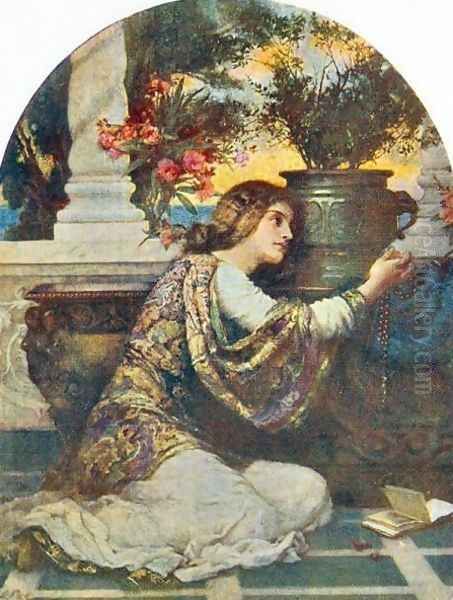
Perhaps her most widely recognized painting is The Lady with the Lamp, completed in 1891. This iconic work depicts Florence Nightingale during the Crimean War, tending to wounded soldiers in the hospital at Scutari. The painting captures a moment of quiet heroism and compassion, with Nightingale, illuminated by her lamp, moving through the darkened ward. The work resonated deeply with the Victorian public, celebrating a national heroine and embodying ideals of duty and self-sacrifice. Its popular appeal was immense, and it was widely reproduced, cementing Rae's reputation. The painting was exhibited at the Royal Academy and later at the World's Columbian Exposition in Chicago in 1893, where it received a medal.
Psyche before the Throne of Venus (1894)
One of Rae's most ambitious and celebrated works is Psyche before the Throne of Venus, exhibited at the Royal Academy in 1894. This large-scale canvas depicts a scene from the classical myth of Cupid and Psyche, as told by Apuleius. The mortal princess Psyche, having angered Venus, stands nude and vulnerable before the enthroned goddess of love, who is surrounded by her attendants. The painting is a tour-de-force of academic skill, showcasing Rae's mastery of composition, colour, and the depiction of multiple nude and semi-nude figures. The central figure of Psyche is rendered with particular sensitivity, conveying her beauty, fear, and humility. The work was a critical success and was purchased by the Walker Art Gallery in Liverpool, a significant public acquisition for a female artist at the time. It demonstrated Rae's ability to compete with her male counterparts, such as John William Waterhouse or Herbert James Draper, who also specialized in large mythological scenes.
Isabella (1897)
Drawing from literary sources, Rae painted Isabella in 1897. This work is inspired by John Keats's poem "Isabella, or the Pot of Basil," which itself is based on a story from Boccaccio's Decameron. The poem tells the tragic tale of Isabella, whose brothers murder her lover, Lorenzo. She exhumes his head and buries it in a pot of basil, which she waters with her tears. Rae's painting likely depicts a moment related to this poignant narrative, showcasing her ability to translate poetic sentiment into visual form. Literary themes were popular among Victorian artists, including the Pre-Raphaelites like Dante Gabriel Rossetti and John Everett Millais, though Rae's treatment would have been more classical in style.
Hylas and the Nymphs (1909)
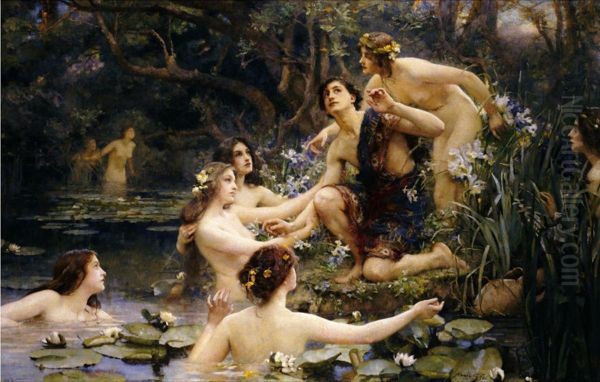
Later in her career, Rae continued to explore mythological themes. Her 1909 work, Hylas and the Nymphs, depicts the handsome youth Hylas, a companion of Hercules, being lured into a spring by water nymphs. This subject was also famously painted by John William Waterhouse in 1896, and Rae's interpretation offers an interesting comparison. Her version, often reproduced as a print, shows Hylas seated by the water's edge, surrounded by alluring nymphs in a lush, verdant setting. It highlights her continued engagement with classical narratives and her skill in rendering idyllic, romantic scenes.
Other Notable Works
Throughout her career, Rae produced many other significant paintings. Doubts, an early work, reportedly caused some controversy, perhaps due to its subject matter or treatment, hinting at her willingness to tackle challenging themes from the outset. She also painted portraits and other allegorical pieces. Her consistent presence at the Royal Academy exhibitions, often with large and ambitious canvases, underscored her dedication and professional standing.
Advocacy for Women Artists
Beyond her personal artistic achievements, Henrietta Rae was a significant advocate for female artists. She was acutely aware of the challenges women faced in the art world and actively worked to promote their visibility and recognition. In 1897, she played a crucial role in organizing the "Exhibition of Works by Women Artists" at Earl's Court as part of the Victorian Era Exhibition. This was a landmark event, bringing together a vast collection of art by women, showcasing their diverse talents and contributions to the Victorian art scene. By taking on such organizational roles, Rae helped to create opportunities for her female peers and challenge the male-dominated structures of the art establishment. Her efforts aligned with the broader women's rights and suffrage movements gaining momentum during this period, in which she also took an interest. Other female artists like Elizabeth Thompson (Lady Butler), known for her military scenes, and Louise Jopling also achieved considerable success, but the path was often more arduous for women.
Comparisons with Contemporaries
Henrietta Rae's work can be situated alongside several key contemporaries. Her classical subjects and polished style align her with academic giants like Leighton, Alma-Tadema, and Poynter. However, her focus on the female form and her perspective as a woman artist offer a distinct voice.
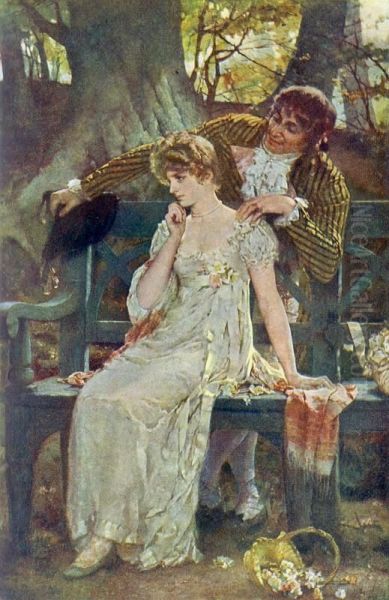
Her work is often compared to that of John William Waterhouse, who also specialized in mythological and literary scenes featuring beautiful women, often in Pre-Raphaelite or Symbolist-inflected styles. While there are thematic overlaps, Rae's classicism is generally more pronounced than Waterhouse's more romantic and mysterious approach. Some critics have noted a stylistic similarity between Rae's work and that of her husband, Ernest Normand, particularly in their shared academic training and interest in narrative subjects, though their primary thematic focuses differed.
Compared to the French academic painters like William-Adolphe Bouguereau or Jean-Léon Gérôme, whose influence was felt internationally, Rae's work shares a similar commitment to technical finesse and idealized beauty, though her subjects were typically drawn from British literary and classical traditions rather than French historical or Orientalist scenes.
Later Career and Legacy
Henrietta Rae continued to paint and exhibit throughout the early 20th century, even as artistic tastes began to shift with the rise of Modernism. The academic, classical style she championed gradually fell out of favour with the avant-garde, but she remained a respected figure. She and her husband, Ernest Normand, continued their artistic pursuits from their home in Upper Norwood. Ernest Normand passed away in 1923. Henrietta Rae died on January 26, 1928, in Upper Norwood, London.
For a period after her death, like many Victorian academic painters, Henrietta Rae's work was somewhat overlooked as modernist aesthetics dominated art historical narratives. However, in recent decades, there has been a significant re-evaluation of Victorian art, and artists like Rae are being rediscovered and appreciated for their skill, ambition, and their unique contributions. Her ability to succeed as a woman in the male-dominated Royal Academy system, her powerful depictions of classical and literary heroines, and her advocacy for fellow women artists mark her as an important figure. Her paintings, found in public collections such as the Walker Art Gallery (Liverpool), the Russell-Cotes Art Gallery & Museum (Bournemouth), and various other British institutions, stand as a testament to her talent and her enduring place in the history of British art. Artists like Lucy Kemp-Welch, known for her paintings of horses, and illustrators like Kate Greenaway also represent the diversity of successful female artists from this period, each navigating the art world in their own way.
Conclusion
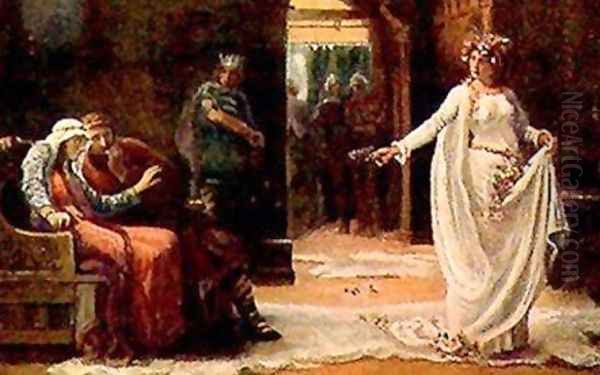
Henrietta Rae was more than just a skilled painter; she was a pioneer who navigated the complexities of the late Victorian art world with determination and vision. Her dedication to classical and allegorical themes, her mastery of the human form, particularly the female nude, and her ambitious large-scale compositions secured her a prominent place among her contemporaries. Her most famous works, such as The Lady with the Lamp and Psyche before the Throne of Venus, continue to captivate audiences with their technical brilliance and narrative power. As an advocate for women artists and a successful professional in her own right, Henrietta Rae's career offers a compelling story of artistic achievement against the backdrop of a changing society, leaving an indelible mark on the landscape of British art.